|
|
|
Sort Order |
|
|
|
Items / Page
|
|
|
|
|
|
|
| Srl | Item |
| 1 |
ID:
144353
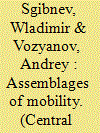

|
|
|
|
|
| Summary/Abstract |
This article addresses reconfigurations of urban space in Central Asia through the lens of marshrutka mobility. Marshrutka-based transport is – together with the bazaar trade – a major sector of Central Asian economy. Although precise data are not available, estimates propose that one family in ten gains its income through it. In spite of its economic and social importance, there has barely been any research on marshrutka mobility so far. The marshrutka mobility phenomenon appears at once wide-ranging and elusive. In order to grasp its complexity, we propose a theory framework based on John Law's concept of fluidity and assemblage. Providing empirical insights from Khujand, in northern Tajikistan, the article addresses marshrutka mobility from a local perspective, notably with regard to regulatory processes of marshrutka-based transport. It also covers the trans-local perspective, with particular attention to global flows of ideas, vehicles, and people.
|
|
|
|
|
|
|
|
|
|
|
|
|
|
|
|
| 2 |
ID:
144350
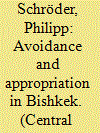

|
|
|
|
|
| Summary/Abstract |
Much has changed since Frunze was renamed Bishkek in 1991 and became the capital of independent Kyrgyzstan. Though it was once considered to be among the ‘greenest’ and most ‘orderly’ cities of the Soviet Union, today many of its long-term residents complain about the new settlements (novostroiki) that have emerged during the last two decades. To Bishkek's urbanites, the recent arrival of migrants is not associated with an escape from rural poverty and a rightful struggle for civic rights, but indicates a massive cultural and aesthetic degradation of familiar urban life. In this article, beyond contesting narratives of cosmopolitan nostalgia vs. legitimate belonging, I investigate how urban practitioners in fact produce and deal with different spaces in the city. My ethnographic accounts not only identify social avoidance as an essential pulse of Bishkek's current rhythm, but also illustrate that after a period of post-rural socialization previously stigmatized migrants may manage to smoothly blend into urban spatial flows and lifestyles.
|
|
|
|
|
|
|
|
|
|
|
|
|
|
|
|
| 3 |
ID:
144351
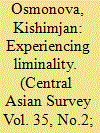

|
|
|
|
|
| Summary/Abstract |
This article is intended to contribute broadly to research in post-socialist urban studies. Based on ethnographic fieldwork and interviews with ‘newcomers’ to the capital, Astana, from different parts of Kazakhstan, I examine the renting practices of newcomers. I analyse the experiences of newcomers in their new urban milieu of Astana, and try to answer the question of what it means to live in the city for various groups of individuals on a daily basis. I examine the Soviet and post-Soviet housing and the continuities of the Soviet legacy when it comes to the institution of propiska (city registration). I show that living in shared flats is a coping strategy to deal with expensive rents and meant to be a transitory step towards homeownership. For this reason many accept high rents and crowded housing as ‘normal’. Furthermore, I argue that informal renting practices are acceptable mostly for young and single people, who are free to experiment with city life, and are on their way to establishing careers and personal lives. However, elderly newcomers and young families with children who do not wish to live in shared flats, but have to rent, feel ‘homeless’ and trapped in ‘liminal housing’. For them, renting is undesirable, and they feel a sense of incarceration if they fail to secure housing.
|
|
|
|
|
|
|
|
|
|
|
|
|
|
|
|
| 4 |
ID:
144349
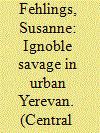

|
|
|
|
|
| Summary/Abstract |
This article focuses on a recent development in the Armenian capital, Yerevan, described by its urban population as a ruralization process. I explore what it means to call something or someone ‘rural’ or ‘urban’, and I compare the social category of ‘rural people’ with the social category of the (old) urban intelligentsia. This includes an analysis and reconsideration of the traditional ‘nature–culture dichotomy’ and its meaning for the architecture and urban planning of Yerevan. It also interrogates the classification of people into newcomers from the countryside, urban dwellers, new elites, and young men called rabiz.
|
|
|
|
|
|
|
|
|
|
|
|
|
|
|
|
| 5 |
ID:
144347


|
|
|
|
|
| Summary/Abstract |
This article traces the multiple ways of ‘manufacturing’ Islamic lifestyles in the urban environment of Tajikistan's capital city, Dushanbe. The city's bazaars serve as a lens through which to observe the conjunction of its booming trade business with Dubai alongside its growing Islamic commodity culture and a religious reformism that is inspired by the materiality and non-materiality of a progressive and hybrid Dubai Islam. Bringing together long-distance trade, urban consumption practices and new forms of public piety in the mobile livelihood of three bazaar traders and sellers, the article provides insights into how the commodification of Islam informs notions of urbanity and modernity in Tajikistan. These notions correspond to the launching of urban renewal and the meta-narrative of Dushanbe's future as a modern city on the rise. Furthermore, the article illustrates the ways in which Dushanbe's Muslims turn bazaars into an urban laboratory for religious agency and cultural identities.
|
|
|
|
|
|
|
|
|
|
|
|
|
|
|
|
| 6 |
ID:
144352
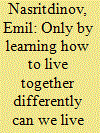

|
|
|
|
|
| Summary/Abstract |
This paper questions the effectiveness and usefulness of the Russian government's policies of migrant integration. Using a unique combination of ethnographic research methods (observations, interviews and survey) with methods from psychology (cognitive mapping) and urban studies (GIS mapping), I depict the presence of Central Asian migrants and their interaction with local long-term residents in two cities of the Russian Federation: Kazan and Saint Petersburg. On the basis of my findings, I argue that the readability (defined as the ease with which the city can be ‘read’ and understood) and legibility (defined as the degree to which individual components of an urban environment are recognizable by their appearance) of urban space in Kazan have positive effects on the relationship between these two communities, while the ambiguity and uncertainty of urban identity in Saint Petersburg make the life of migrants very vulnerable and unpredictable, and result in the growth of xenophobic views among the local residents. This allows me to argue that the policy of migrant integration will be more successful if it is built on learning to live with differences, instead of trying to ‘Russify’ migrants or create various forms of supra-ethnic identity.
|
|
|
|
|
|
|
|
|
|
|
|
|
|
|
|
| 7 |
ID:
144354


|
|
|
|
|
| Summary/Abstract |
Post-socialist urban dynamics in the Caucasus have been characterized by uneven processes of rebuilding and reclaiming of sacred spaces. Exploring re-emerging Shia Muslim lifestyles in post-conflict Armenia around Yerevan's Blue Mosque, I examine how a religious place is perceived and used in everyday life. Built at the end of the eighteenth century in a multi-religious environment, today the Blue Mosque is associated with the political body symbolizing the recent Iranian–Armenian friendship and with Iran's soft-power policy in the Caucasus. The ethnographic research reveals that the mosque complex is not an isolated sacred site emphasizing differences between Iranian migrants and Armenian locals, worshippers, and non-worshippers, but a spatial expression of the coming together of groups from different backgrounds and of the vernacular hybridity that existed in Yerevan in the past. In spite of the invisibility and the silence of the Blue Mosque's past from the point of view of government officials, the physical restoration of the mosque is triggering unembodied memories of people in conscious and unconscious reconstructions of the multi-religious past. The question, is to what extent does the Blue Mosque contribute to a visible rediversification of religious and ethnic life in Armenia?
|
|
|
|
|
|
|
|
|
|
|
|
|
|
|
|
| 8 |
ID:
144348


|
|
|
|
|
| Summary/Abstract |
The shopping mall entered Central Asia's commercial sector as a result of the economic transformation of post-Soviet space. Constructed near the centre of the city, the shopping mall overwrites the urban landscape, dominating it as a symbol of modernity. It functions as a gateway of global consumerist culture to the Eurasian steppe. Using the MEGA shopping mall in Aktobe, in western Kazakhstan, as an example, this article shows that the building acts as a stage for the construction of a new social and cultural space. This study focuses on the ways in which young women interact with the mall's spaces. The mall turns out to be a playground not only for children, but also for the whole younger generation, who come to this unique place to see and be seen. The mall became a hot spot of youth culture in the post-socialist worker's city by offering more than a mere shelter from dust and snow storms on the steppe. The available amenities made it a favourite place for meeting, consuming and dreaming. Young women especially are attracted to MEGA to experience the newest fashions and build social relationships.
|
|
|
|
|
|
|
|
|
|
|
|
|
|
|
|
|
|
|
|
|